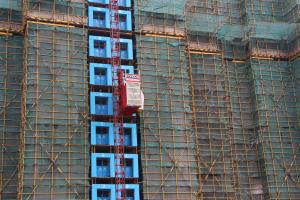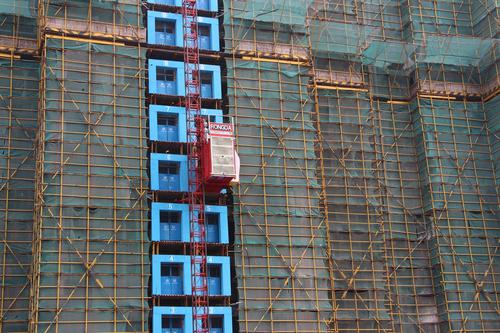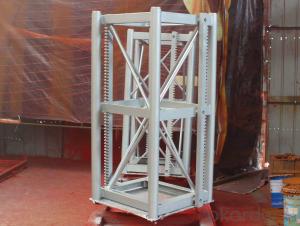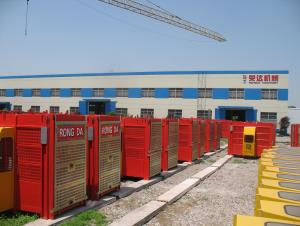SC200B Single Cage Construction Hoist
- Loading Port:
- Shanghai
- Payment Terms:
- TT or LC
- Min Order Qty:
- -
- Supply Capability:
- 60 set/month
OKorder Service Pledge
OKorder Financial Service
You Might Also Like
To serve the increasing demand for high rise construction, we developed the high speed VF hoist.
It has the following features:
Adopts the most advanced VF speed control device and microcomputer programmable logic controller.
Stepless speed control helps eliminate the concussion during start up and braking, steady the operation process, and ensures automated leveling.
Adopts open loop V/F control; the speed control precision can reach +2~3%. Realizes accurate low speed positioning of the hoist and avoids slipping during downward stopping of hoist.
The VF system has current-restriction function, ensuring a small current when motor start up and reducing the concussion to power supply. It reduces the energy consumption and mitigates effects to on site electric equipments.
The steadiness during running mitigates concussion to mechanical parts, reduces wears of rack, pinion and the brake and prolongs the spare parts’ life.
The VF system also has the over voltage protection, low voltage protection, overcurrent, overload and anti-stalling protection functions.
The system applies the special software for hoists developed by our company, making the operation more safe and reliable.
Technical data of frequency conversion SC Series building hoist(middle speed)
Type | Payload (kg) | Lifting speed(m/min) | ||
Single cage hoist | No counterweight | SC100 | 1000 | 0~60 |
SC120 | 1200 | 0~60 | ||
SC160 | 1600 | 0~60 | ||
SC200 | 2000 | 0~60 | ||
SC250 | 2500 | 0~60 | ||
SC270 | 2700 | 0~60 | ||
SC300 | 3000 | 0~60 | ||
SC320 | 3200 | 0~60 | ||
With counterweight | SCD200 | 2000 | 0~60 | |
SCD250 | 2500 | 0~60 | ||
SCD270 | 2700 | 0~60 | ||
SCD300 | 3000 | 0~60 | ||
SCD320 | 3200 | 0~60 | ||
Twin cage hoist | No counterweight | SC100/100 | 2x1000 | 0~60 |
SC120/120 | 2x1200 | 0~60 | ||
SC160/160 | 2x1600 | 0~60 | ||
SC200/200 | 2x2000 | 0~60 | ||
SC250/250 | 2x2500 | 0~60 | ||
SC270/270 | 2x2700 | 0~60 | ||
SC300/300 | 2x3000 | 0~60 | ||
SC320/320 | 2x3200 | 0~60 | ||
With counterweight | SCD200/200 | 2x2000 | 0~60 | |
SCD250/250 | 2x2500 | 0~60 | ||
SCD270/270 | 2x2700 | 0~60 | ||
SCD300/300 | 2x3000 | 0~60 | ||
SCD320/320 | 2x3200 | 0~60 |
Remark:
1.The recommended cage dimension(LxWxH)(m): 2.0x1.0x2.5, 2.5x1.0x2.5, 2.5x1.3x2.5, 3.0x1.3x2.5, 3.2x1.5x2.5, 3.7x1.5x2.5, 4.0x1.5x2.5, 4.2x1.5x2.5 etc. We can manufacture cages of other size according to the user.
2.The cage and the door material can be aluminum molded board, punched-plate, figured aluminum board or other type according to your requirements.
3.The mast and the tie-in surface can adopt paint-spray, or hot galvanizing processing.
4.Both domestic and imported driving system are available
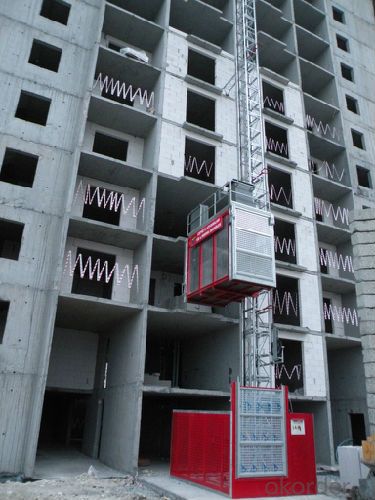
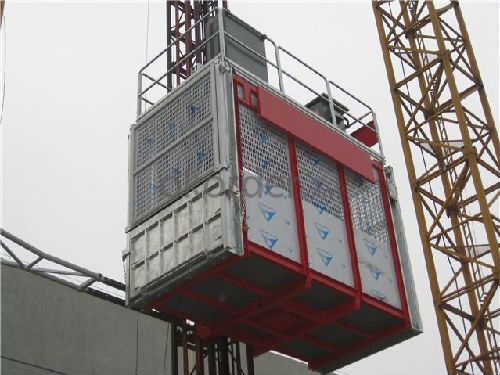
- Q: Is it possible to use a building hoist for material transportation in both indoor and outdoor environments, especially in confined spaces within industrial zones?
- <p>Yes, building hoists can be used both indoors and outdoors in industrial areas, even with limited space. They are designed for material transportation during construction and are adaptable to various environments. For indoor use, hoists are often enclosed to protect from weather and debris. Outdoors, they may require additional weatherproofing. In confined spaces, compact and tower hoists are used to save space. However, safety regulations and space constraints must be considered to ensure proper installation and operation.</p>
- Q: The working principle of construction elevator
- How the elevator works: The main bearing structure is self-formed system, which is low on construction. It more driven by force, drive devices are installed on the hanging basket, through the gear and rack drive system, the mutual cooperation, so as to realize the rise and fall of the elevator.
- Q: Is it possible to utilize building hoists in environments with high altitudes?
- <p>Yes, building hoists can be used in high-altitude environments, but their performance may be affected. At high altitudes, reduced air density can lead to decreased efficiency in hoist operations, particularly those powered by combustion engines. It's crucial to select hoists designed for high-altitude use, which may include features such as high-altitude ignition systems and special lubricants. Additionally, regular maintenance and adjustments to the hoist's operation parameters are necessary to ensure safety and optimal performance.</p>
- Q: A building hoist is a mechanical device used in construction to lift materials and sometimes workers vertically. It is essential for the efficient movement of materials in high-rise construction.
- <p>The function of a building hoist is to facilitate the vertical transportation of materials, equipment, and sometimes workers within a construction site. It is particularly useful in high-rise buildings where manual lifting would be inefficient and unsafe. A building hoist allows for the rapid and safe movement of materials, reducing labor costs and improving construction speed.</p>
- Q: This question asks about the procedures and methods for maintaining and repairing a building hoist, which is a type of lifting equipment used in construction.
- <p>To maintain and repair a building hoist, follow these steps: Regularly inspect the hoist for any signs of wear and tear or malfunction. Lubricate moving parts as per the manufacturer's recommendations to reduce friction and prevent rust. Check and replace worn cables, pulleys, and other components. Ensure that safety devices like limit switches and emergency stops are functioning correctly. For repairs, address any mechanical failures, replace broken parts, and make sure the electrical system is in good condition. Always follow the manufacturer's guidelines and consult with a professional if the issue is complex or beyond your expertise. Regular maintenance and prompt repairs can extend the life of the hoist and ensure safe operation.</p>
- Q: This question asks for guidelines on the safe operation of a building hoist, a device used to lift materials in construction.
- <p>To use a building hoist safely, follow these guidelines: Ensure the hoist is properly installed and inspected by a qualified person. Never exceed the hoist's weight limit. Keep the hoist area clear of obstacles and ensure all safety devices are functioning. Do not use the hoist if there are any visible defects or damage. Always secure the load properly and ensure it is balanced. Never leave the hoist unattended while in operation. Use hand signals or a communication system to coordinate with the operator. Regularly inspect and maintain the hoist to prevent accidents. Always follow the manufacturer's instructions and adhere to local safety regulations.</p>
- Q: Is it possible to use two lifting devices simultaneously to lift an object that is heavier than the maximum weight each device can handle individually?
- <p>Yes, two lifting devices can be used together to lift a heavier object than either one can handle alone, provided that both devices are capable of supporting the combined weight and are properly synchronized. This requires careful planning and coordination to ensure the safety of the operation and the integrity of the lifting devices. The total weight capacity of the combined system should be greater than the weight of the object being lifted, and the devices must be designed to work in tandem without overloading or causing damage.</p>
- Q: This question asks about the typical issues encountered with construction hoists and seeks solutions to address these problems.
- <p>Common problems with building hoists include mechanical failures, electrical issues, safety hazards, and improper maintenance. Mechanical failures can be fixed by regular inspection and timely replacement of worn-out parts. Electrical issues are often resolved by checking wiring and connections, and using surge protectors. Safety hazards can be mitigated by ensuring all safety features are operational and by providing proper training to operators. Improper maintenance can be addressed by establishing a routine maintenance schedule and ensuring that all personnel follow safety protocols. Regular inspections, prompt repairs, and operator training are key to maintaining the functionality and safety of building hoists.</p>
- Q: Is it possible to substitute a hydraulic cylinder for an electric motor in a building hoist system?
- <p>A hydraulic cylinder can indeed be used as a replacement for a motor in a building hoist, but it requires a different system design. Hydraulic systems use fluid pressure to generate linear motion, which can be harnessed to lift and lower loads. They offer high power-to-weight ratios and can handle heavy loads, making them suitable for hoisting applications. However, they require a power source for the hydraulic pump, and the system must be designed to manage fluid flow, pressure, and safety features. Unlike electric motors, hydraulic systems also need regular maintenance and can be less energy-efficient. Despite these differences, with proper design and engineering, a hydraulic cylinder can effectively replace an electric motor in a hoist system.</p>
- Q: Is it possible for a hydraulic cylinder in a building hoist to experience leakage or failure?
- <p>Yes, a hydraulic cylinder in a building hoist can leak or break. Leaks can occur due to worn seals, damaged hoses, or corroded cylinder walls. Breakage may result from excessive pressure, manufacturing defects, or metal fatigue. Regular maintenance and inspection are crucial to detect and prevent such issues, ensuring the safety and efficiency of the hoist system.</p>
Send your message to us
SC200B Single Cage Construction Hoist
- Loading Port:
- Shanghai
- Payment Terms:
- TT or LC
- Min Order Qty:
- -
- Supply Capability:
- 60 set/month
OKorder Service Pledge
OKorder Financial Service
Similar products
Hot products
Hot Searches
Related keywords
